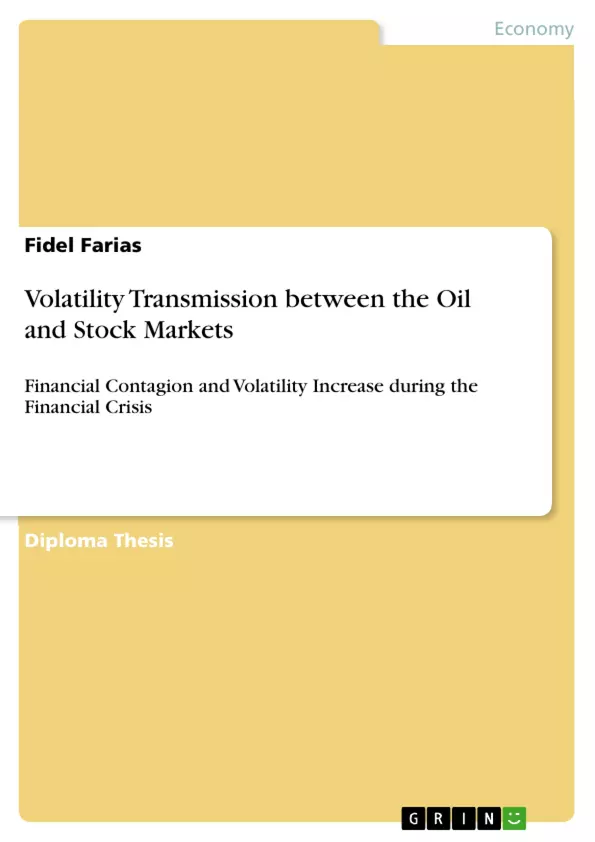Besonders in jüngster Zeit kommt der Analyse von Ölpreisvolatilität aus volkswirtschaftlicher Sicht eine bedeutende Rolle zu. Gegenwärtig werden bestimmte Rohstoffe wie Rohöl als relevante Anlageinstrumenten von Investoren benutzt, um sich gegen Risiken an den Finanzmärkten abzusichern.
Diese Diplomarbeit beschäftigt sich mit der Berechnung von Ölpreisvolatilität in der Zeitperiode von Januar 2002 bis Juli 2009. Dabei werden Berechnungen von Ölpreisvolatilität während der Finanzkrise im Jahre 2008 untersucht. Diese Finanzkrise hat sich tiefgreifend auf die Entwicklung der Preise von Kapital- und Finanzgütern ausgewirkt. Dabei weisen die exzessiven gemessenen Werte von Preisvolatilität während der Finanzkrise auf eine strukturelle Veränderung der Preisbildung von Kapital- und Finanzgütern an den Kapital- und Finanzmärkten hin. Interessanterweise lassen sich bei der Analyse von Ölpreisvolatilität bedeutende Fakten feststellen, deren Existenz die gegenwärtig verwendeten statistischen Modelle, die sich mit der Messung von Preisvolatilität befassen, in künftigen Arbeiten komplementieren könnten.
Im Rahmen dieser Diplomarbeit werden fünf wichtige statistische Modelle analysiert: ARCH, GARCH, BEKK-GARCH und Markov-switching Modell. Dazu wird aus den Ölpreisdaten der letzten 8 Jahre die tägliche Preisvolatilität berechnet, um mögliche Relationen zwischen der Volatilität am Ölmarkt und der Volatilität am Finanzmarkt zu untersuchen. Dabei werden diese implementierten Verfahren auf ihre Gültigkeit in Berechnung und Vorhersage von plötzlichen Preisveränderungen untersucht. Insbesondere wird darauf eingegangen unter welchen Bedingungen die Verfahrensergebnisse als zuverlässig gelten.
Diese Diplomarbeit wurde im Rahmen eines Forschungspraktikums bei der Organisation erdölexportierender Länder (OPEC) in Wien, Österreich unter Betreuung des Lehrstuhls für Wirtschaftstheorie der Universität Potsdam, fertiggestellt
Inhaltsverzeichnis (Table of Contents)
- 1 INTRODUCTION
- 2 VOLATILITY: CONCEPT AND EMPIRICAL EVIDENCE
- 2.1 Definition of Price Volatility
- 2.2 Analysis of Oil Price Volatility
- 2.3 Economic Sources of Price Volatility
- 3 METHODOLOGY
- 3.1 Modelling Oil Price Volatility
- 3.2 Univariate Volatility Models
- 3.2.1 Historical Volatility
- 3.2.2 ARCH
- 3.2.3 GARCH
- 3.2.4 GJR-GARCH
- 3.2.5 ARMA-GJR-GARCH
- 3.2.6 Conditional Distribution
- 3.2.7 Regime-Switching Models
- 3.2.8 Markov-Switching Models
- 3.2.9 Markov-Switching ARCH (SWARCH)
- 3.2.10 Indicators of synchronization
- 3.3 Bivariate GARCH Models - Volatility Transmission Models
- 3.3.1 VECH
- 3.3.2 BEKK GARCH (1,1)
- 4 FINANCIAL MARKET AND OIL PRICE VOLATILITY: CONTAGION AND TRANSMISSION CHANNELS
- 4.1 Definition of Contagion
- 5 EMPIRICAL SECTION
- 5.1 Data description
- 5.2 Estimation of Oil Price Volatility
- 5.2.1 Univariate GARCH (1,1) and GJR-GARCH (1,1)
- 5.2.2 Results of GARCH (1,1) and GJR-GARCH (1,1) Models
- 5.3 Volatility Transmission
- 5.3.1 Markov-Switching Estimation
- 5.3.2 Indicator of Synchronization
- 5.4 Estimation of BEKK GARCH (1,1)
- 5.4.1 Testing for Volatility Transmission
- 5.4.2 Empirical Results
- 6 DISCUSSION OF THE EMPIRICAL RESULTS
- 6.1 Volatility Transmission Channel – Financial Deleveraging
- 6.2 Extension of the model
- 6.2.1 Overvaluation and GARCH (1,1)
- Citar trabajo
- Fidel Farias (Autor), 2010, Volatility Transmission between the Oil and Stock Markets, Múnich, GRIN Verlag, https://www.grin.com/document/335376



